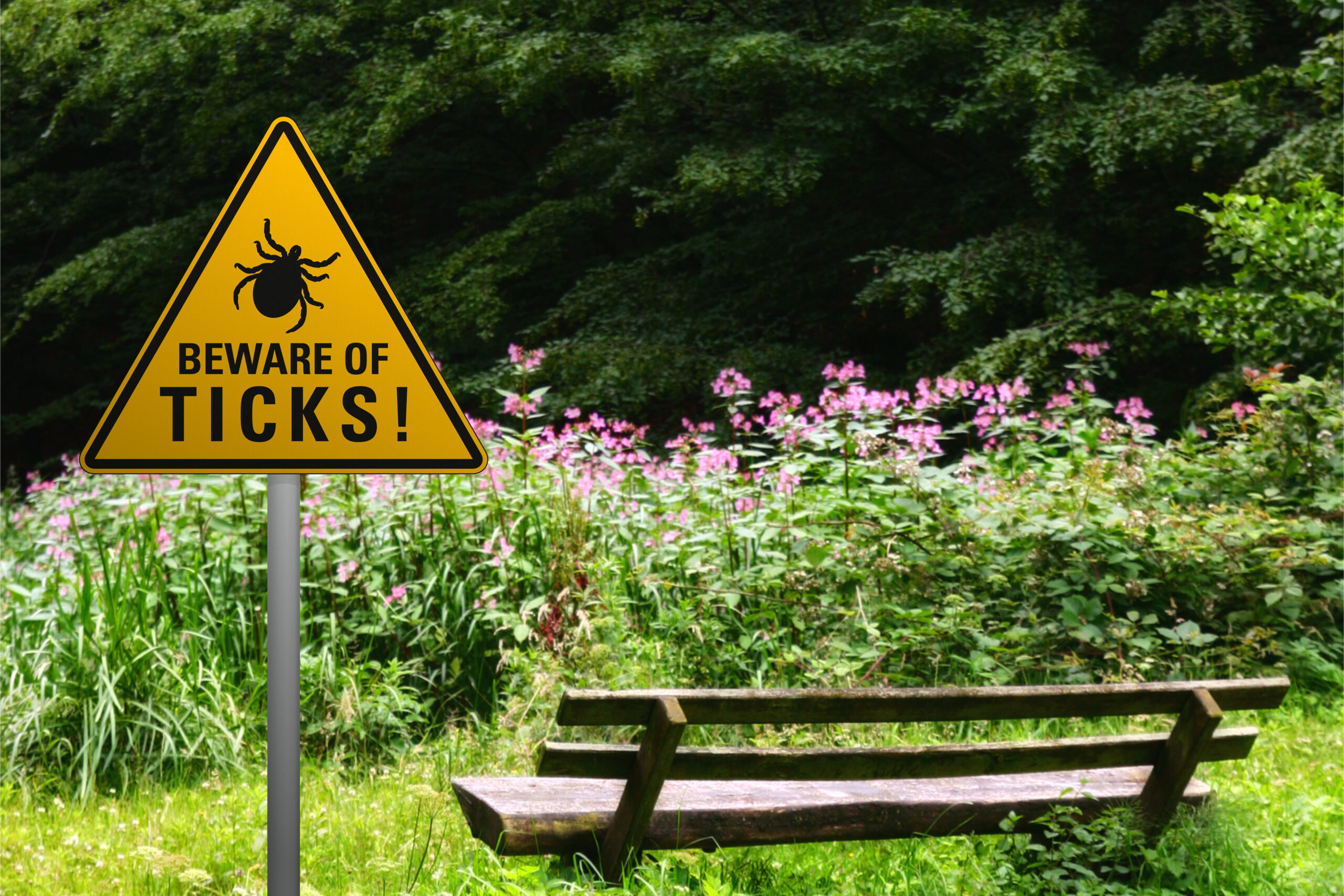
Fall brings a lot of things we love: pumpkin spice lattes, cinnamon donuts, apple picking, and, depending on where you live, colorful leaves, to name a few. But while you’re outside enjoying the cooler weather on family fun activities with your kids and dogs, you need to watch out for ticks. According to Global Lyme Alliance, “fall also brings unwelcome visitors: adult black-legged or deer ticks that can transmit Lyme and other tick-borne diseases. While ticks are commonly found in heavily wooded areas, they also thrive in backyard grasses, gardens, unmanicured hedges and leaf litter. In fact, experts say that the majority of people who develop tick-borne diseases came in contact with the tick that made them sick right in their own backyards.”
Leah Alexander, MD, FAAP, pediatrician, and medical consultant, tells LittleThings, “Lyme disease in children can be prevented by taking several precautions. If deer ticks are endemic to a particular geographic area, parents should apply an insect repellent before the child spends time outdoors. A product with 10 to 30% DEET is recommended. Spraying clothing can be as effective as spraying the skin. If planning a hiking or camping trip in such areas, lightweight long-sleeved shirts and pants can protect the skin. Tucking pant legs into socks can prevent ticks from finding a way underneath them. There are DEET-free insect repellents, but these may not be as effective.”

After you spend time outdoors, immediately do a tick check. Dr. Alexander says, “Parents should examine their child's skin and hair for ticks, removing any that are present as soon as possible. An easy way to remove these ticks is to cover them with petroleum jelly for 15 minutes. This causes the ticks to release their grasp, allowing them to be plucked away with tweezers.”
Showering will help, but it won’t stop ticks from latching onto your skin. Alexander says, “It may be a good idea for kids to take a shower or bath after spending time outdoors because they will need to undress fully, and the skin can be better checked for ticks. Unfortunately, ticks cannot be ‘showered off.’"

What’s even more alarming is that tick bites don’t always leave that notorious red bull's-eye ring. “The bacterium that causes Lyme disease doesn't always produce the red bull's-eye-shaped rash around the bite location in kids,” warns Alexander. “There may or may not be discomfort associated with this rash. However, this sign is often absent in children. Lyme disease is diagnosed several weeks after the initial bite when prolonged fevers, joint pain/swelling, or multiple bull's-eye rashes develop. In other cases, partial paralysis of the facial nerves occurs, called Bell's palsy. In rare situations, the bacterium may cause meningitis associated with seizures.”
She continues, “There are many types and sizes of ticks, and parents often confuse deer ticks with others (i.e., dog ticks). The kind of ticks that cause Lyme disease, however, is the size of a pinhead and becomes slightly more significant when engorged. These ticks tend to attach to the skin very firmly, and much effort is needed to remove them.”

Pediatric Lyme disease is diagnosed based on a history of finding a firmly attached tick and presenting symptoms, according to Alexander. “Although blood Lyme titer tests are available, they typically do not reveal an antibody response until four to six weeks after exposure. If there are symptoms such as joint swelling or Bell's palsy, it is worth doing blood work to confirm the diagnosis. Lyme meningitis is diagnosed by evaluating the cerebral spinal fluid with a lumbar puncture.”

There are treatments for Lyme. “In children, Lyme disease is easily treated with antibiotics, either 21 days of oral amoxicillin or 14 days of doxycycline,” says Alexander. “Neurological symptoms, however, may require hospitalization and intravenous antibiotics. These courses of treatment are effective in both reducing the symptoms and clearing the bacterial infection. Most children are cured of Lyme disease after an appropriate course of antibiotics. Symptoms resolve, and there is no need for additional treatment. In cases of Lyme meningitis, follow-up with a neurologist may be necessary to assess for cognitive deficits or to manage seizures. This complication is extremely rare, however. I have only seen one such case in 22 years of pediatric practice. Although many adults develop long-term complications from Lyme disease, this is uncommon in children.”

Rest assured, “Lyme disease in children is treatable and curable,” says Alexander.
Ticks are also a threat to dogs, so it’s important to take preventative measures before and after your pet goes on hikes or plays in the backyard. Albert Ahn, DVM, a passionate advocate of pet health for over 25 years and veterinary advisor for MYOS Pet, tells LittleThings, “Each year we have been seeing a rise in the tick population, and experts have confirmed that there is a huge explosion of ticks this year. Ticks are present in the spring and summer but most active in the fall as they head into a feeding frenzy before the winter.”

The best way to check your dog for ticks and seed ticks (baby ticks) is to do so at least once a day and to use a brightly lit room for better visualization, according to Dr. Ahn. “Run your hands and fingers slowly through your dog's haircoat, paying special attention for any unusual lumps that could be an attached tick. While running your hands through your dog's haircoat, carefully inspect the skin to see if there are any adult or seed ticks that may be crawling around. Seed ticks are very tiny and can look like small specks of ground black pepper crawling on the skin (or through the hair). They can be very easy to miss and can often be found on and around the paws.”

Lyme disease presents a risk to dogs. Ahn explains, “Lyme disease in dogs damages the joints, causing joint disease. When a dog’s joints hurt, they are not willing to move as much, which then results in loss of muscle mass. Pet parents should consult with their vet on reliable tick-preventive products and/or vaccinate against Lyme disease. But if your dog has been diagnosed with Lyme, in addition to the antibiotics that will be prescribed, you can help support your dog’s recovery by providing them supplements for muscle and joint fatigue. Supplements with glucosamine and collagen have been shown to improve joint stiffness, while a supplement containing Fortetropin can help reduce muscle loss, increase muscle mass, and improve overall muscle health.”
Signs your dog has Lyme, according to Ahn, are swollen lymph nodes, swollen joints, lameness in one or more joints, loss of appetite (anorexia), and fatigue. “Kidney disease can [also] be potentially associated with a Lyme disease infection in your dog,” notes Ahn.
Pet parents should be aware that “Lyme disease in dogs can be very debilitating as it can be in people. For this reason, it is vitally important that pet parents use a high-quality flea and tick medication to help protect their furry family members from the potentially dangerous diseases that ticks can carry including Lyme disease, Ehrlichia, and Anaplasma, to name a few.”

One thing you don’t have to worry about is getting Lyme from your dog, should your dog carry the disease. “There is no credible evidence that dogs can transmit Lyme disease to people,” assures Ahn.
However, Ahn points out that “dogs can bring ticks into the household, which is why it is so important to work with your veterinarian to select an appropriate flea and tick preventative for your dog.”




